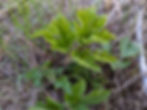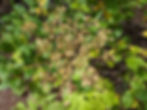Cow parsnip receives some undeserved disrespect outside of the foraging world and deserves more love than it gets within the foraging world. It’s one of the easier-to-learn plants in the carrot family, it’s native to North America, and has many edible parts! Its relation and resemblance to the invasive giant hogweed, Heracleum mantegazzianum, have led to some misinformation and unnecessary removal with herbicide and other control methods. Let’s learn how to identify cow parsnip, some of its look-a-likes, and how to harvest and eat it!

Description
Cow parsnip, Heracleum maximum, is a large perennial in the carrot, celery, and parsley family, Apiaceae. This family is known for having some great edible plants, many of which can be found in the produce and spice sections of most grocery stores, but it’s also known for having some of the most deadly plants in it as well—namely, poison hemlock, Conium maculatum, and water hemlock, Cicuta maculata.
Luckily, cow parsnip is easily distinguished from these deadly species. It has large compound leaves made up of three palmately lobed leaflets. The leaves are somewhat irregular, with deep lobes and broad teeth with sharply pointed (accuminate) tips. They are hairy and slightly depressed or folded along the veins. The leaf stems (petioles) can be over two feet long and are hollow, somewhat ribbed, covered in stiff hairs, and end in a sheath.

The flower stalks of cow parsnip can be over six feet tall and, like the petioles, are hollow, ribbed, and covered in stiff hair. The skin on the petioles and flower stalks is usually a mix of green and purple, though the purple is more streaked or gradually mixed with the green instead of splotchy like in giant hogweed or the hemlocks. The flower is a large compound umbel comprising groups of small, five-petaled, asymmetrical, white flowers. Eventually, those flowers become small, flat, green fruits that mature into a light brown color and are divided into two seeds.

Important: cow parsnip and many closely related plants are phototoxic and can cause phytophotodermatitis, an inflammatory reaction caused by exposing skin to the juice of these plants and ultraviolet light such as sunlight. The reaction can be as severe as extreme redness, swelling, and blistering. This should not scare you away from cow parsnip, though! There are many common plants that are known to cause this reaction, including limes and other citruses, figs, and other ficus species, and many other species in Apiaceae, including celery, parsley, and parsnips. The best prevention is to keep the juice from contacting your skin by wearing gloves and being conscious of how you’re handling the harvested plant. If you are exposed, wash the area with soap and cold water and prevent exposure to the sun with sunscreen and by covering the area. I have harvested lots of cow parsnip with bare hands and have never had any issues.

Range & Habitats
Cow parsnip is the only species of its genus, Heracleum, native to North America. It has been documented across much of the United States, excluding the Southeast and Hawaii, and can be found in every Canadian province. It has not been reported in Mexico or any of the other southern regions of North America. It’s least common in the Great Plains but has large populations across both coasts, the Midwest, and the Rocky Mountains. It prefers habitats with moisture and nutrient-rich soil, such as along lakes, rivers, and wet forests. In Colorado, it can be found from our lowest elevations along the rivers in the Front Range and west slope, all the way into our alpine ecosystems.

Potential Look-alikes
The information in the description above should be enough to properly identify cow parsnip. However, look-alike information is regularly requested, so here are some possible species that could be confused with cow parsnip. This list is not comprehensive and may not be relevant to your region. Remember only to eat wild foods once you're 100% confident in your identification and comfortable with trying something new.
Giant hogweed, Heracleum mantegazzianum, is similar to cow parsnip but larger in all aspects. It is an invasive species in North America and has been documented in the Northeastern and Northwestern states and provinces. It potentially shares a similar edibility to cow parsnip, but its juice is highly phototoxic.
Other plants in the genus Heracleum which includes over 80 species, some of which are quite similar-looking to cow parsnips. such as H. sosnowskyi and H. persicum. It would be rare to find these in the same habitat, but they likely have the same edibility as cow parsnips and are also phototoxic.
In Colorado, it’s very common to find cow parsnip growing with giant angelica, Angelica ampla. Angelica has a pinnately compound leaf with more and smaller leaflets. Its flowers are spherical instead of flat umbels. It is also edible but has phototoxic juice like cow parsnip.
Other large species in the Apiaceae family. As mentioned above, this includes some very deadly species, so it is vital to learn these plants well and take your time to become comfortable with their identification before consuming them.

Join The Forage Colorado Newsletter!
Sign up for our email newsletter to get seasonal foraging tips, wild food classes,
early access to foraging events, and more!
Foraging Cow Parsnip: Edibility & Harvesting
Cow parsnip has many edible parts! The young leaves in the early season can be eaten raw (be careful not to get the juice on your lips) or cooked and added to many dishes. They have a strongly unique flavor that is hard to describe. Cow parsnip has some similarities to parsley but with a lot more complexity. To harvest, look for leaves that are still quite ruffled and just emerging from the ground. These can be cut away from the plant using a knife or scissors. I learned from Sam Thayer and Alan Bergo that the fermented leaves of European Heracleum species were used in the original version of borscht. The petioles and young flower stalks can be eaten raw or used in various dishes to impart some of those celery or parsley-like flavors. Soups and stews would be a great choice! To harvest, look for still-growing leaves or flower stalks that have not bloomed yet. Cut them from the plants using a knife or scissors, then peel the stalks just before using them. Ideally, peel them inside to reduce the chance of exposing the juice to ultraviolet light. The peeled stalks could probably also be candied, like angelica, but I have never tried this.

The unopened flower buds are probably the most interesting part of this plant to eat. While growing, they look like swollen nodules towards the top of the flower stalks, but inside there are developing flowers. Alan Brego calls these “cocoon broccoli”, which is a very apt description! These can be harvested like the stalks and usually are more mildly flavored than the leaves or stalks. They can be cooked whole or sliced into rounds. Frying them in a light batter is one of my preferred ways to eat them! Finally, the fruits and seeds are a wonderfully unique spice! They can be harvested and dried when green, which provides a fresher and subtler flavor, or they can be allowed to dry on the plant and be harvested. Reference the Persian spice golpar, which comes from Heracleum persicum, for inspiration on how to use cow parsnip.

Foraging Calendar
To learn more about the best seasons to harvest this species and many other wild foods, check out my Foraging Calendar & Wild Food Database! You can try the demo version to learn more, and join my Patreon to gain full access to the Foraging Calendar and other exclusive perks! Joining is the best way to support all the work I put into my content and website to help you learn about foraging! Thank you for checking it out!

